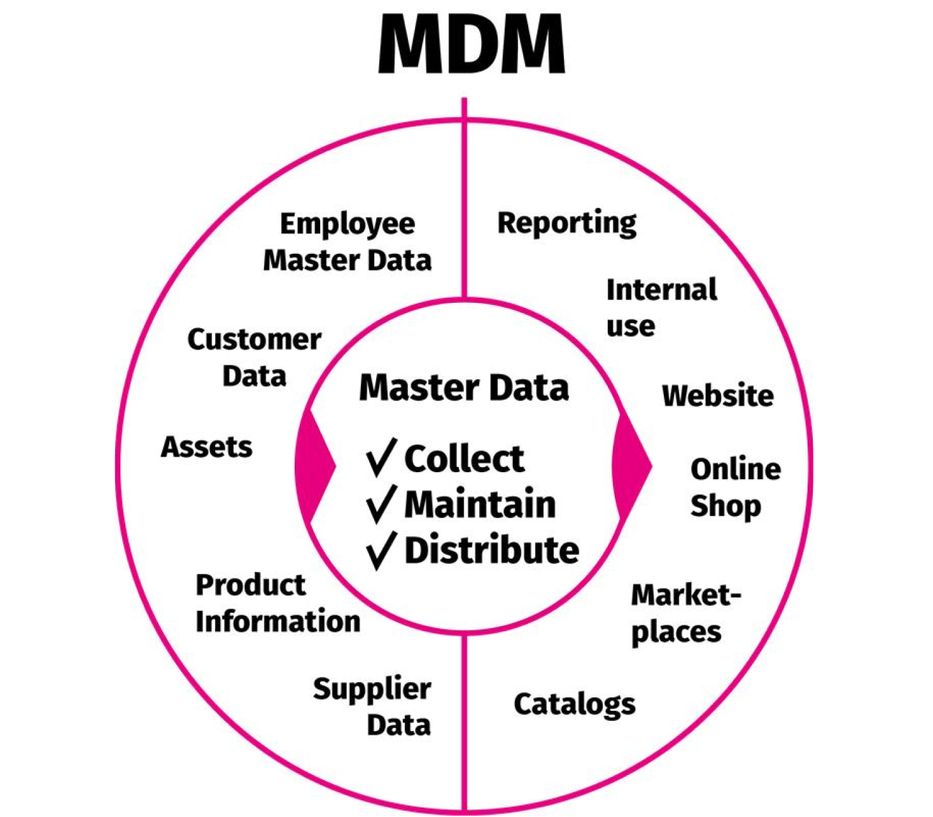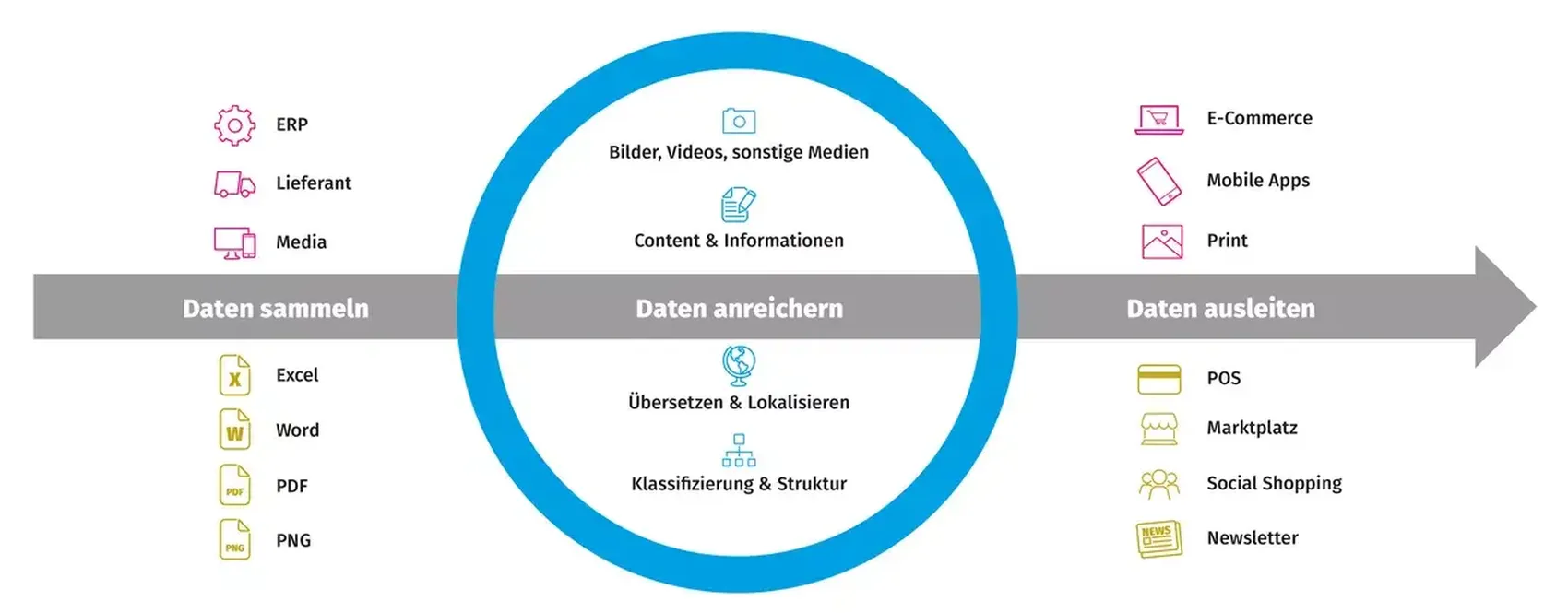Everything around your product data
Optimize your product information
Collecting, maintaining and distributing high-quality product information is one of the foundations of your business success today. With need-based and customized information, you present your products in all sales channels and in the best light. We accompany you with our experience from all areas of digitalization and support you on the way to your successful PIM project.
New requirements in digital commerce
With PIM on all channels The growing complexity in digital commerce forces companies to optimize the creation, management and distribution of their product data. With PIM, you manage to offer your customers the right product information at the right time and in the right place. Save yourself and your trading partners complicated data handling through standardized refinement and transfer processes. Eliminate misinformation faster and increase your data quality. Your trading partners and customers receive the information exactly as they need it - with minimal effort. Process costs decrease, your market attractiveness and sales potential increase.
What is a PIM system?
A product information management system (PIM system) is software for the central management of product information. The main tasks of the PIM system are the collection, enrichment and distribution of assortment- and product-specific data. Centralization in one system not only reduces process costs. At the same time, existing and new sales channels can be supplied with optimized data more quickly. The time-to-market of new products is minimized, the quality of information is improved and the sales potential is increased.

What is the difference between PIM, MDM and DAM?

While the core functionality of Product Information Management lies in the central administration of product information such as product features and descriptive texts, closely related data management systems should be mentioned in this context. Master Data Management (MDM) represents the central consolidation and distribution of information located in the company for a wide variety of areas. MDM can thus include not only financial and order data, but also information on suppliers and customers, as well as the company's own stores. MDM systems often also include the option of product data management. Due to their wealth of functions, some PIM systems can also be found in the MDM area, although the focus is on providing product information. In addition to information management in PIM and MDM, all so-called assets are managed in Data Asset Management (DAM). The term "assets" in this context describes, among other things, all documents (PDF, XLSX, DOC, etc.), images, videos and other media of a company. In the DAM system, for example, all required product images (normal view, detailed view, application image, etc.) can be prepared and meta information such as license validity and alternative texts can be added. Most PIM systems also already have some DAM functionalities equipped. In complex scenarios, or if infrastructure is already in place, the PIM can be supplied with assets by a connected specialized DAM system.

PIM

Central system for the collection, enrichment and distribution of product information to all marketing and sales channels (e.g. online store, marketplaces, CMS, print catalogs, data sheets).

MDM

Centralization of different company data (e.g. customer, order, financial data, etc.). PIM functionality may also be present here.

DAM

Central management of assets (PDFs, images, videos, etc.) and distribution to other systems (e.g. PIM/MDM, online store, marketplaces, CMS).
The PIM system serves as a link between the source and target systems for your product information. All data is first collected and consolidated from the source systems and then passed on to the appropriate recipients. Data sources include the ERP system, Product Lifecycle Management (PLM), DAM system and internal departments such as marketing or product management, as well as external sources such as (upstream) suppliers. The data is imported directly via interfaces or by import, for example as an XSLX or CSV file.
On the other hand, the target systems of product information include digital marketing and sales channels such as websites and online stores, as well as publishing tools for print media such as catalogs, product data sheets and flyers. Changes in the digital customer lifecycle are also constantly expanding the range of target systems to include new aspects such as social shopping, chat bots, and voice search-optimized product data.
In the standard scenario, new products are initially created in the enterprise resource planning (ERP) system. The item master data is transferred from here to your PIM system. They usually include the basic information about the product. Under certain circumstances, this can also be just the article number. Life is breathed into the products in the PIM system. The other information is either created directly in the PIM system or brought together from connected systems. Here, short and long product names are added, descriptive texts are entered, and all characteristics are maintained. The required information fields can be configured as needed in the PIM system. They are usually referred to as "attributes". A comprehensive image of your products is thus created from text, number and other attribute types.
In the PIM system, data quality is enhanced on a workflow basis. Images, videos and other media are assigned to products and content is prepared for different languages and regions. For this purpose, some systems offer special translation workflows, which can also be used to involve external service providers in data preparation. In order to provide the data for all channels in the correct structure, it can be output according to different classifications. This also includes industry-specific output (e.g. BMEcat, OCI) according to industry standards such as ETIM or eCl@ss.
In addition to the preparation in the system, the suitable PIM system is also characterized by the fact that all incoming data formats can be read and the prepared data can be made available to the target systems in the correct format.

What are the benefits of PIM?
A competitive strategy with different sales channels requires the provision of channel-specific information in order to offer the customer a convincing product presentation at all touch points. The diverse data preparation and provision not only harbors a high potential for errors, but also means a high personnel effort. With the right PIM system, process costs can be reduced in the company and sales potential increased.
By integrating a central process for the structured management of product information, you prevent duplicate data maintenance processes and at the same time increase the consistency of your product information across all channels. Time-consuming manual activities are streamlined and standard processes automated.
Flexible import options (data mapping) help you quickly transfer product information into your central product structure. New suppliers and other source systems are thus quickly connected. This leads to faster uptake of new products and product updates. Thanks to optimal preparation workflows, the latest product information is available for use in marketing and sales within a very short time. New distribution channels and sales markets are quickly connected through comprehensive localization functions.
The channel-specific derivation through manual and automated connections reduces the time-to-market in all target systems. Demand-driven content also increases conversion rates and reduces bounce rates. Return rates are reduced through better and more accurate product descriptions, and customer satisfaction is strengthened. Satisfied customers lead to increased customer lifetime value. Further additional sales can be generated in this context by referencing up-sell and cross-sell products (e.g.: accessories, spare parts, follow-up articles).
The PIM system gives you full control over product information and maximizes data security in the company through configurable read and write rights in rights and role management. Audit-proof data storage guarantees traceability of data history and versioning of processing statuses.
In particular, the introduction of a PIM system provides companies in regulated markets with a central control authority for compliance with predefined data and product standards, including definable mandatory attributes. The PIM system is thus more than a central repository for product information. Rather, it is a platform for more quality, transparency, digital transformation and growth.
Finding and integrating the right PIM system for your company is fraught with hurdles and questions to consider.
How can we ensure that no faulty/incorrect product data is distributed?
Do we really know our requirements for a PIM system?
Will all key service providers/partners be considered when integrating the new solution?
How do we avoid the transfer of contaminated data during the initial data import (onboarding)?
How can we optimize the data enrichment processes?
How do we ensure that we meet the project schedule?
How do we avoid saving money at the wrong end by integrating inappropriate software? (Standard solution vs. customizing effort)
We will be happy to answer your questions about implementing a PIM system. Contact us now.
PIM at diva-e
We advise you along all relevant business areas to find the best solution for your Product Information Management and Master Data Management. Our experts offer you the best possible support from the initial consultation, through system selection, to integration of the appropriate system and further support in productive operation.
System selection (requirements analysis and evaluation)
The investment in the integrative modernization of your product data flows must be worthwhile. We support you in determining and evaluating the savings potential and opportunities for further business development that you will gain by using a central PIM system.
In doing so, we also take into account the costs incurred for the integration and operation of the new system. The actual course of the project depends, of course, not least on the desired scope of innovation, the data status in the company to date as well as on the specific schedule and the available capacities of the customer. First of all, we start with the preliminary project, from the needs analysis to the long-list candidate identification, short-listing and vendor presentations to the selection of the most suitable system for you.
To find the best possible solution for you, we draw on the entire expertise of our PIM experts, our partner contacts and our holistic experience in omni-channel commerce. Based on the findings of a comprehensive needs and process analysis, we determine the desired target architecture and accompany you from a candidate longlist to the shortlist to the selection of the right PIM system.
Proof of Concept
The proof of concept (PoC) is an important milestone in project development. It creates the basis for further work by confirming the project concept and proving the feasibility of a project in principle. This serves as the basis for decision-making in the further course of the project.
The components of a PoC in the PIM area are usually feasibility studies regarding the desired data model, required workflows and the transfer of data to selected target systems. At the same time, the PoC enables risks to be identified and minimized. The result of the PoC project is a recommendation for or against the introduction of the evaluated system.
Integration
After selecting the appropriate system, we plan the actual integration. The graphic below illustrates that the course of the project varies depending on the customer's requirements. To get the system up and running as quickly as possible, we define an MVP together. This "Minimal Viable Product" describes an integration and development status from which the new PIM process can go live. Depending on how many interfaces have to be programmed/configured right at the start, this MVP will take place after just a few months, while work continues on the complete integration in the main project.
A multi-stage scoping phase is followed by the actual integration and implementation of the system. We configure the data model, the necessary editing and release workflows, as well as all required interfaces for the import and export of your product information.
Hypercare
In all our projects we follow a "hypercare" approach. This means that we do not leave you alone even after the successful completion of the main project. At the end of the project, we already prepare the necessary training materials and are available for staff training and workshops. Together we identify possible further development perspectives for your new PIM process. We attach great importance to getting to know our customers and working together to ensure their future success.
























